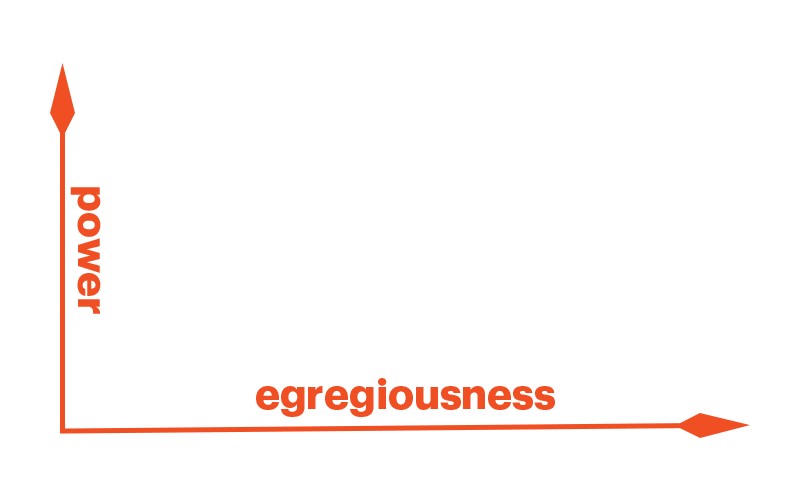Sign up for the daily CJR newsletter.
In this month’s edition, CJR Editor Kyle Pope and resident management guru Jill Geisler discuss how newsrooms can improve sexual-harassment training and ensure respect for all those involved while following up on allegations, as well as best practices for handling holiday parties
Kyle: As newsroom leaders deal with sexual misconduct reports—old and new—what should they take into account in order to respect and protect victims while ensuring a fair process for the accused?
Jill: Let me offer a basic framework: a misconduct axis that takes into account power and egregiousness (or clout and slime, if you prefer.)
The egregiousness line is straightforward, ranging from verbal harassment to physical assault.
The greater your power, the greater your obligation to act with moral character. When people have higher status, staff may feel powerless to push back against their objectionable behavior, fearful of exclusion or reprisal. For that reason, behaviors that might rank lower on the egregiousness scale will nonetheless be weighted more heavily against them.
ICYMI: MSNBC does the right thing
Power isn’t vested solely in managers. Many employees have informal power, from an organization’s “stars” to those who serve as mentors, advisors, or trainers. Their influence carries with it an expectation of trustworthiness.
That old expression “rank has its privileges” is upended when it comes to misconduct. A person with clout who hits on those without it courts trouble. An employee who asks a co-worker for a date risks only rejection.
CareerBuilder’s latest survey says 41 percent of respondents have dated a co-worker. Some fall in love. Full disclosure: I met my husband of 35 years in the newsroom. Neither of us was a supervisor then, but managers have been known to wed their staffers. Slate Executive Editor Allison Benedikt wrote a smart first-person account of marrying her boss, coupled with a nuanced call for discernment in this moment of enlightenment.
Given the seriousness of this moment, I’m less concerned about a boss navigating a true love situation than I am about finally tackling the silence and systems that enabled harassment and discrimination.
Let’s look at additional factors to consider in assessing any harassment situation:
- Recency of the behavior: How long ago did it happen?
- Pervasiveness of behavior: Is there a pattern?
- Vulnerability of the victim: Was this person an intern, a trainee, a temp, a freelancer, someone with little job security or no union protection?
- Multiplying misconduct: Was the impropriety compounded by racism, intimidation, bullying, dishonesty, or retaliation?
- Impact on victim: Regardless of the level of egregiousness, how did it affect the victim?
- Impact on organizational trust and culture: How does this case affect the staff’s morale, trust in their leaders, and confidence in a workplace culture of integrity?
Kyle: Should managers change their organizations’ approach to holiday parties, in light of concerns about sexual misconduct?
Jill: This one’s easy. Talk to a good sampling of folks on your staff—and weight that sample with lots of women. Ask for their input to create an event that maximizes fun and eliminates harassment.
These kinds of conversations are important. They have impact in ways written policies don’t. Your team members hear their leader talk about what matters, far beyond protecting the company from lawsuits. Drop your fear of coming across as “preachy.” You can be responsible and real as you tell staff what you stand for.
ICYMI: Yikes! Here are headlines editors probably wish they could take back
If, like Vox, you go the prudent route and drop the open bar from this year’s event, don’t pocket the savings. Turn it into gift cards for staff. Or give it to charity. Share that decision with your employees, too.
The more managers talk openly about their earnest efforts to fight discrimination and harassment—and the more they listen to staff—the faster they’ll accomplish change.
Kyle: Many organizations are going to upgrade their anti-harassment training. What should that include?
Jill: According to an EEOC report, there’s scant research on the effectiveness of current training, because most studies are done in academic “lab” settings rather than in real workplaces. After all, if media organizations declined to respond to CJR’s survey merely asking for information on their harassment policies, you can imagine how thrilled they’d be to have researchers hanging around their newsrooms.
The best analysis I’ve seen comes from a University of Oregon law professor, Elizabeth Tippett, who undertook the mind-numbing task of reviewing 74 different anti-harassment trainings used between 1980 and 2016.
“Early trainings framed harassment as an abuse of power, and as a business problem—a productivity drain, morale killer and source of litigation costs. The power-based frame is largely absent in more recent trainings, subsumed by the business justification. More recent trainings characterize harassment as a violation of the company’s policy, and advise victims and supervisors to invoke the company’s institutionalized systems for investigating and responding to harassment.”
Between the “don’t harm our business” message and the use of dated, scripted, hokey videos, it’s easy to see why such sessions may not produce great results.
Additionally, many organizations present their one-size-fits-all anti-harassment training online, to be efficient and economical. That’s a mistake.
After years of designing and delivering training for news managers, here’s what I believe:
- Training about human interactions should be delivered face-to-face.
- Training should be customized for the learners.
- Instructors must have “street cred” (aka real-world newsroom knowledge) or journalists will reject them.
- Instructors must never lecture, but design interactive sessions that recognize and respect what I call “the wisdom in the room.” That’s the existing knowledge that people have and want to share, even if it’s by debating and questioning the instructor.
- When people discover their own answers, thanks to the instructor’s guidance, the learning has impact. As I always teach: People fall in love with ideas and solutions of their own creation. My job is to set the table for that to happen.
So what would I put into the training?
- Knowledge of the law, but also why legal focus alone is wrong. Safe workplaces are a moral imperative.
- The connection of harassment to discrimination
- The immorality of discrimination
- The importance of civility
- The responsibilities of power and the obscenity of powerlessness
- How to be an “active bystander” (complete with practice) who speaks up when witnessing harassment or bullying.
- How to have difficult conversations to address questionable behaviors. Out of all the topics I teach managers, this is the interactive session they tend to value most. No one learns this in J-school, but it’s a critical skill for both peer-to-peer and boss-to-employee situations.
- How to document and report, using the company’s process.
The other thing I’d put into any employee training session is—managers. People notice when bosses aren’t involved—and staffers get an entirely different message when managers are engaged, side-by-side, in learning.
Then, it’s up to leaders to keep the values of the training alive in daily interactions, so that civility and equity are embedded in the culture.
Here’s some help with that important work: On January 9, the Newseum and Freedom Forum will host the Power Shift Summit. I’m moderating this meeting of 150 top media leaders. We will focus on managing in this historic #MeToo moment and changing systems that foster harassment and discrimination. The summit will be livestreamed, so newsrooms everywhere can benefit.
ICYMI: “This story is about to get even uglier, if that’s imaginable”
Has America ever needed a media defender more than now? Help us by joining CJR today.








